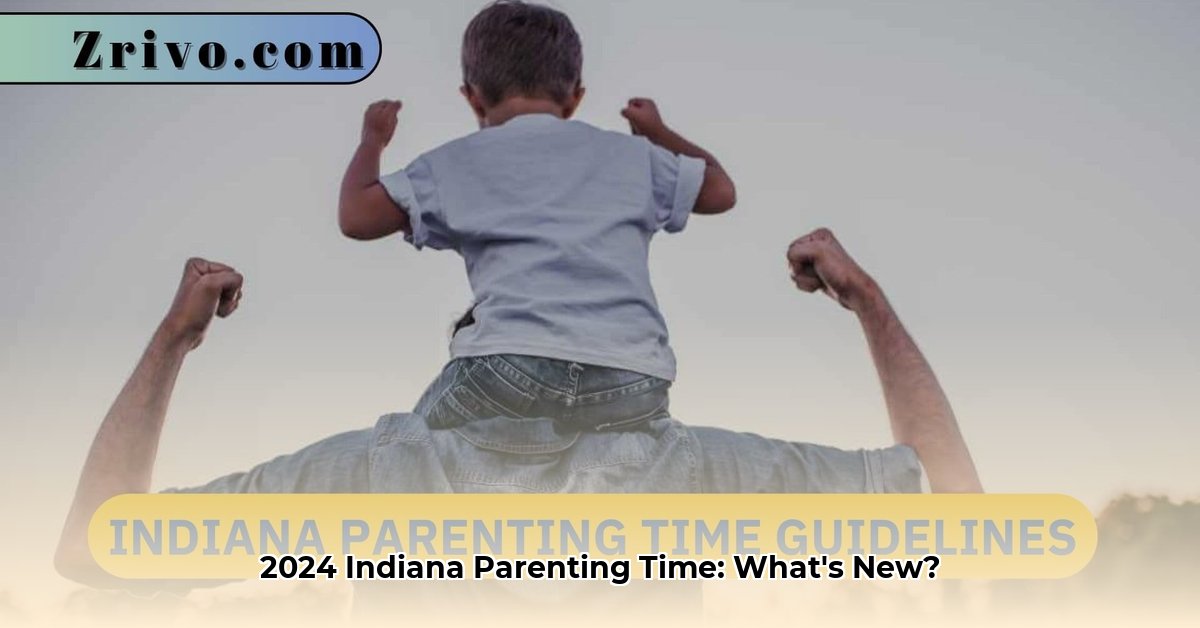This guide provides a comprehensive overview of Indiana’s Parenting Time Guidelines, designed to help parents understand and apply these guidelines to their specific situations. While we strive to offer clear and accessible information, this guide is for informational purposes only and does not constitute legal advice. Consulting with an attorney is crucial for personalized guidance. You can download the official Indiana Parenting Time Guidelines PDF directly from the Indiana Courts website (always verify you have the most current version).
Understanding the Basics
Before diving into the guidelines, let’s clarify some key terms:
- Legal Custody: This determines who has the legal right to make major decisions regarding the child’s upbringing, including education, healthcare, and religious upbringing. Legal custody can be joint (shared between parents) or sole (granted to one parent).
- Physical Custody: This refers to where the child primarily resides. Like legal custody, physical custody can also be joint or sole.
- Parenting Time: Often referred to as “visitation,” parenting time refers to the schedule outlining when each parent spends time with the child.
- Shared Parenting: This generally indicates that both parents have significant, though not necessarily equal, parenting time and often involves joint legal custody.
Overview of Indiana’s Parenting Time Guidelines
The Indiana Parenting Time Guidelines aim to maximize a child’s time with both parents (when safe and appropriate) while minimizing parental conflict. These guidelines are not rigid rules but a framework. Judges have the authority to deviate from them based on the unique circumstances of each case, always prioritizing the child’s best interests. Current research suggests that maintaining strong relationships with both parents, when possible, generally benefits children’s well-being, but the specifics are still under investigation and vary from case to case.
Age-Based Recommendations
The guidelines offer age-appropriate parenting time recommendations, recognizing that a toddler’s needs differ from a teenager’s. While not mandatory, these suggestions provide a starting point:
General Age-Based Recommendations
| Age Range | Typical Parenting Time Schedule Considerations |
|---|---|
| Infant – 3 Years | Frequent, short visits with the non-custodial parent, prioritizing consistent contact |
| 3 – 5 Years | Gradually increasing visit lengths, potentially introducing overnight stays |
| School-Age | Alternating weekends and holidays, balancing school schedules |
| Pre-teen/Teen | More flexible schedules, accommodating the child’s increasing independence and activities |
It’s important to note that these are general tendencies, not strict rules. Some research indicates that frequent transitions for very young children might be disruptive, while other studies suggest maintaining frequent contact is paramount. The best approach depends on the specific child and family dynamics.
Holiday Schedules
The guidelines often suggest alternating holidays between parents to ensure fair and consistent time with each. This predictability can reduce conflict and provide structure for the child. However, families may agree upon alternative arrangements.
Modifying Orders
Life is full of changes. If circumstances significantly change—such as a job relocation, a change in a child’s needs, or other substantial events—you can petition the court to modify an existing parenting time order. The guidelines themselves are unlikely to be sufficient grounds for modification, but they inform the court’s assessment of reasonable parenting time arrangements.
Role of Parenting Coordinators
Parenting coordinators are neutral third parties who can assist parents in communication, scheduling, and resolving disputes related to parenting time. They can be particularly helpful when co-parenting is challenging.
Creating a Parenting Plan: A Step-by-Step Guide
A parenting plan is a crucial roadmap for raising your child after separation or divorce. The Indiana Parenting Time Guidelines can be a valuable resource in developing this plan:
- Review the Guidelines: Familiarize yourself with the age-appropriate recommendations and general principles.
- Prioritize Your Child’s Needs: Consider your child’s age, personality, routines, school schedule, and any special needs.
- Communicate with the Other Parent: Open and respectful communication, possibly facilitated by mediation, is essential.
- Formalize the Plan: Document the agreed-upon arrangements in writing to avoid future misunderstandings.
- Seek Court Approval: Submit the parenting plan to the court for approval to make it legally binding.
Common Challenges and FAQs
Q: What if one parent relocates?
A: Relocation significantly impacts parenting time and requires court approval. The court will consider the distance, the reasons for the move, and the potential effects on the child’s relationship with both parents.
Q: What if we can’t agree on a parenting time schedule?
A: Mediation is often a helpful first step. If mediation fails, the court will make a determination based on the child’s best interests.
Q: What if the other parent consistently violates the parenting time order?
A: You can file a motion with the court to enforce the order. The court may impose penalties for violations.
Resources and Legal Assistance
- Indiana Courts Website: Access official forms, guidelines, and other relevant information.
- Indiana Legal Services: Provides legal aid to low-income individuals.
- Pro Bono Indiana: Connects eligible individuals with volunteer attorneys.
Staying Informed: Updates and Changes
Laws and guidelines can be revised. It’s essential to stay informed about updates to the Indiana Parenting Time Guidelines. Regularly check the Indiana Courts website or consult with a legal professional. Staying current helps ensure your parenting plan remains compliant and protects your rights and your child’s best interests.
Understanding Legal vs. Physical Custody in Indiana (In-Depth)
Legal and physical custody are distinct concepts. Legal custody concerns decision-making authority regarding the child’s upbringing. Physical custody dictates where the child primarily lives. Either type can be joint (shared) or sole (granted to one parent). Here’s a breakdown:
| Custody Type | Description |
|---|---|
| Sole Legal Custody | One parent has exclusive legal decision-making authority. |
| Joint Legal Custody | Both parents share legal decision-making authority. |
| Sole Physical Custody | The child resides primarily with one parent. |
| Joint Physical Custody | The child’s time is divided between both parents, though not necessarily equally. |
Judges determine custody based on the “best interests of the child,” considering several factors:
- Each parent’s ability to provide a stable environment.
- The child’s relationship with each parent.
- The child’s wishes (if of sufficient age and maturity).
- Family dynamics and the potential for conflict.
Indiana Parenting Time Guidelines and Age (In-Depth)
The guidelines consider the child’s developmental stage when suggesting parenting time schedules. While flexible, they provide a starting point. Infants and toddlers may benefit from shorter, more frequent visits with the non-custodial parent. As children mature, longer visits, including overnights and extended stays, may become more appropriate. Research is ongoing regarding the impact of frequent transitions on young children, balancing the need for stability with maintaining parental bonds.
Modifying Your Indiana Parenting Time Order (In-Depth)
Modifying a parenting time order requires demonstrating a “substantial change in circumstances” to the court. This could include relocation, job changes, or changes in the child’s needs. Here’s the process:
- Demonstrate Substantial Change: Gather evidence supporting the significant change.
- File a Petition: Submit a formal request (Petition to Modify) with the court.
- Provide Notice: Inform the other parent of the pending modification.
- Mediation: Attempt to resolve the issue through mediation.
- Hearing (if necessary): If mediation fails, the court will hold a hearing.
Remember, legal representation is invaluable during this process.
This expanded guide offers a more comprehensive overview of Indiana’s Parenting Time Guidelines, combining instructional and informational elements to aid your understanding. While detailed, it’s still crucial to remember this is informational and not legal advice. Consulting an attorney is essential for advice specific to your situation.
- 200+ Co-Parenting Quotes: Inspiration, Humor, and Wisdom for Every Stage - February 5, 2025
- Parenting Teens with Love and Logic: A Practical Guide to Raising Responsible Adults - February 5, 2025
- Indiana Parenting Time Guidelines PDF (2024): Download & Understand - February 4, 2025















